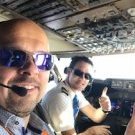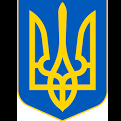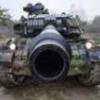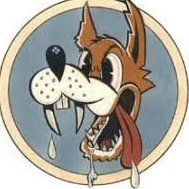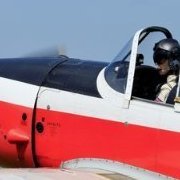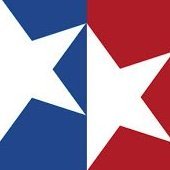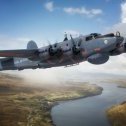Another update! This may be my last before I have to head off to the UK so I made sure to pack it with exciting stuff and drama. More drama than excitement but there you go.
Things were looking tough as I was still waiting on the decals and really struggling for things to keep advancing.
First order of the day was to prime all the remaining parts to get them to a point where white was actually, ehrrr... white.
.
Then things were blued. Oh what a pleasure it was to spray something other that that darned white. Unfortunately, I got a little bit of paint creep under the pasking at the radiused corners. I probably should have not attempted masking when I had just been to the opticians and they had dilated my pupils. I'll try and remember that for future visits.
Other bits also got blued and the observant among you will immediately notice that I completely omitted to mask off for the leading edge of the elevators. Idiot!
Fixed now.
I've no idea why this shot is so faded but it is, so there. Those Triangular plates at the tailplane root are I believe what that humungous arrowhead panel lines on the fin were supposed to be representing. (see photo below this one).
Yes, this arrowhead. Nothing like the1:1. I'm rather glad I decided to fill it when I repositioned the tailplane.
With work on the fuselage almost at a halt, and wings were drying I decided it was time to attack the last jobs on the floats. Rudders and rigging.
Sticking the rudders on was easy enough.
But then I had to rig the darned things.
I started off at the back end and worked my way forward. That is after I spent about half a day trying to figure out what to use for the actual rigging wires. After trying several different materials I settled on 0.18mm fishing line. It was clear (of course!) so I used a silver paint pen to try and coat the line to make it look more "wire-like". It sort of worked.
A few hours later and I had something that looked as if it might work. I realise now that I have some of the pulleys slightly out of position, but one way or another I'm going to make this work. Once there's an aircraft sitting on top of this you'll be hard pushed to see anything at all anyways.
Rigging is now complete, with the exception of the 4 wires which attach to the aircraft. I just know those are going to be so much fun trying to attach when the floats are part of the aircraft structure. That way madness lies.
The remaining 4 doors got their windows fitted.
Then another sort of milestone moment - the wings got their clear coat. Hooray! For those that are wondering - I managed to remove most of the overspray with the use of a sharpened cocktail stick. Now I feel I'm really getting somewhere.
Wing struts also got blued.
Then the access steps got colored in too.
Don't worry, I know I mentioned drama - just hold on, there's plenty of drama to come in a little while.
Before that though... Pitot.
The kit offering is up to their usual standards so there was no question of even thinking about using it... not even as a template. I found some Albion Alloys 0.6mm tubing which seemed about the right diameter. The only problem with tubing is that when you try and bend it, it tends to kink instead of forming a nice curved bend. I attempted to alleviate that by insert some wire to prevent the tube collapsing.
I lined up the wire flush with the end of the tube, then retracted the wire about 5 or 6mm before the bends were added - that kept the opening of the tube an actual opening, and the wire was still in the right places to prevent the tube kinking at the bends.
The kit part really is terrible. Overscale, bends too sharp and that sticky-outy bit near the end is on the wrong side. They have it on the underside when it should sit on the top side as can be seen here.
The overall shape looks about right to me.
So far...
That little vane (?) caused a problem - how on earth to replicate it?
I came up with this idea... I cut a sliver of 5 thou brass and curved it around the tube. I thin pinched it off (ooh-er missus) where the two end met on the opposite side of the tube.
WHen I had it where I wanted it, I lightly applied some solder which was sucked up into the join and held it all fast.
After that it was a simple case of trimming it back to size and cleaning up with some wire wool.
Okay, it's not exactly the right shape, but it's close enough and hopefully won't look so bad when painted up.
It was around this time that Fate decided to jump right on top of me and remind me just who I am, and who I'm dealing with. There I was feeling very pleased with myself after making that pitot and I thought - hey a nice easy job to finish off the day after all that work - Let's just Mr Metal Primer the pitot ready for coloring in another day.
Mr Metal Primer was duly brought down from the shelf of many colors and a drop or two extracted and dropped in a mixing cup. Being the neat worker that I am, for once I decided to return Mr Color Metal Primer back to it's home.
I placed Mr Metal Primer back on the shelf in it's rightful place and asd I brought my arm back down...
Whoa!
What the F... F... F... Flippin heck?
I had two prongs sticking out the top of my vise which I was using to hold the wings as they dried after the clear coat. As I brought my arm back down, my elbow caught one of the wings and you can see the result.
Is it fixable?
Ehhrrr... No. It's not worth even trying.
Luckily though, as is my habit when I print - I usually print some spares and therefore I had another wing waiting in the ... wings so to speak.
Here we go again. Dagnabbit.
As you can guess I am very annoyed with myself right now. That was entirely preventable and was a stoopid stoopid mistake on my part.
Nothing for it but to start all over again on the new wing. It's not that it's a hard or difficult job, it's that it is so time consuming. Multiple coats of white, white, and more white. Waiting overnight to apply the next round of white and having to set the wing fence in position on the new wing. Just so bloody annoying. It's probably about a weeks work when I take drying time and such into account.
Oh well. It is what it is.
Until next time - and watch out for errant elbows folks!




.thumb.jpg.2c282efcc138b7cf7f1e1586a9c534d2.jpg)


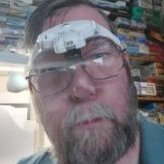
.thumb.jpg.6f3aa09e7d259a38a41486a6baf70912.jpg)

